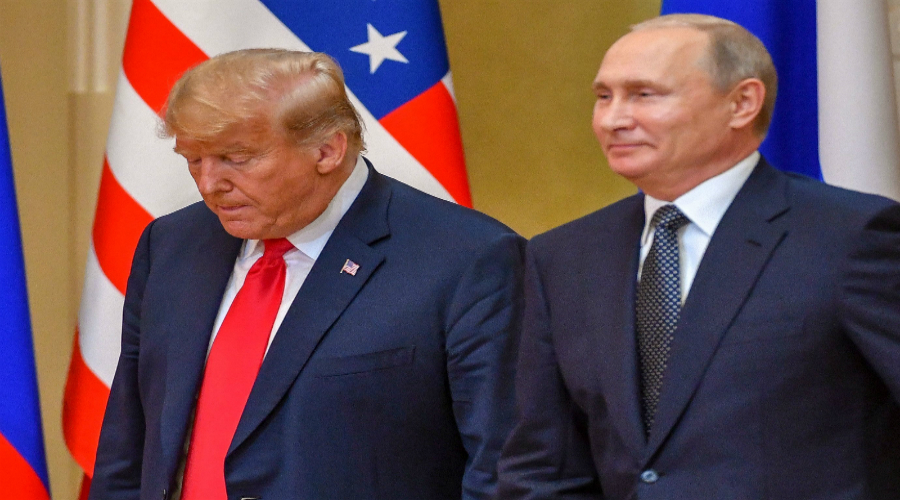US president Donald Trump’s remarks at the press conference with his Russian counterpart Vladimir Putin, after the end of the Helsinki Summit on 16 July 2018, demonstrate that Washington will keep its troops in Syria. This is contrary to Trump’s statement, in April 2018, that he wanted to pull out the American troops of Syria, which was met with strong opposition and criticism from the military and political circles in Washington, who argued that the withdrawal of US troops would pave the way for Iran to expand its influence in Syria. Hence, it can be argued that Trump followed the “advice” of his National Security advisor John Bolton and the military officials in this regard, based on numerous estimates that although the US force in Syria, with its current 2,200 military personnel, is limited, it remains important.
These indicators run counter to leaks, which transpired in May 2018, in what was known as the US Ambassador David Satterfield’s “deal”, to end the Iranian presence in Syria in exchange for dismantling al-Tanf base in southern Syria. It is said to be based on repeated Russian demands and comes as part of Moscow’s attempts to reformulate Syrian border security arrangements with neighbouring countries, where al-Qaeda dominates the Iraq-Jordan-Israel border triangle.
The military cooperation, which was detailed in reports and estimates of some US think tanks in parallel with the Helsinki Summit, is based on the strategic importance of the al-Tanf base, which was established within the framework of the international coalition against ISIS. This contradicts the statements of Russian officials over the past period, which indicated that the base’s strategic weight has declined following the military defeat of ISIS and after the US military ceased its support for the Syrian opposition. And in the absence of logistical support, the base has become vulnerable to the regime and its Russian allies, hence they exploited this situation to eliminate the central stronghold of the opposition in the south.
Multiple Motives
There are key motives for Washington to continue its military role in Syria during the next period, as follows:
1- Expanding the role of the Pentagon: this achieved though continuing the regular military strikes against ISIS groups on the southern border, as well as conducting further discussions with the Russian military officials, such as the talks held weeks ahead of the Helsinki Summit, on June 8, 2018, between Russia’s chief of staff General Valery Gerasimov and his US counterpart General Joseph Dunford. According to a statement issued after those talks, the two sides discussed the Syrian issue as part of the security dossiers and joint military relations. It was the third meeting over the past two years. Remarkably, President Trump focused during the press conference in Helsinki, on the “role of the military on both sides in the management of the Syrian conflict”.
2- Maintaining al-Tanf base: This is based on the fact that the US rejected the idea of dismantling it in exchange for an end to the Iranian presence in Syria. Numerous reports have pointed out that John Bolton and the US military officials have led the rejection camp, arguing that there are no reliable guarantees to assess Russia’s ability to end Iranian presence in Syria. Thus, the primary role of al-Tanf base will likely center on confronting the growing Iranian presence in Syria and blocking Iran’s attempts to establish a land corridor to the Mediterranean.
3- Enhancing Israeli role: Israel sought to take advantage of the Helsinki Summit to reinforce its capacity to participate in the drafting of security arrangements during the next phase, particularly with respect to ending the Iranian presence in Syria. in this context, Israeli Prime Minister Benjamin Netanyahu was keen to visit Russia again ahead of the summit, and President Trump emphasized in Helsinki the importance of ensuring Israeli national security. This concurs with Israel’s continued air strikes against targets in Syria, the latest of which was a month-old raid against the Iraqi Hezbollah Brigades that were transferring weapons between Iraq and Syria at the town of al-Hiri, near the border city of al-Bukamal, sending a message that Israel would expand the confrontation lines with Iran beyond the borders with Syria.
That operation in particular demonstrates that there is coordination between al-Tanf base and the Israeli army. Such coordination cannot be separated from the Syrian-Israeli border security arrangements, which prompted the US to stop supporting the Syrian opposition in Daraa in favour of making way for the return of the Israeli-Syrian disengagement arrangements, in accordance with the 1974 agreement.
A Settlement on the Shelf
President Trump’s remarks do not show that Washington has put forward its vision of a settlement in Syria, as evident in the dominance of the military topic over the Helsinki talks. That is why many estimates argue that Washington is running low on time and options in this regard, especially given the realities of the Russian role on the ground, both at the political and military levels, and hence it will once again be compelled to resume coordination with Turkey. However, such step hits obstacles: the continued coordination between Turkey and Russia and the growing tension between Ankara and Washington over the former’s S-400 missile deal it is seeking to conclude with Moscow.
Thus, judging by the outcome of the Helsinki Summit, there appears to be a tendency within the US Administration to resist President Trump’s desire to withdraw from Syria in order to preclude a recurrence of the problem of Iran filling the ensuing void, which would in turn affect the interests of Washington and its allies in the region, foremost among them Israel. However, this military track does not correspond to a political one that reinforces this vision, which will cause confusion in Washington’s handling of the political and operational developments on the ground in Syria over the next period.


